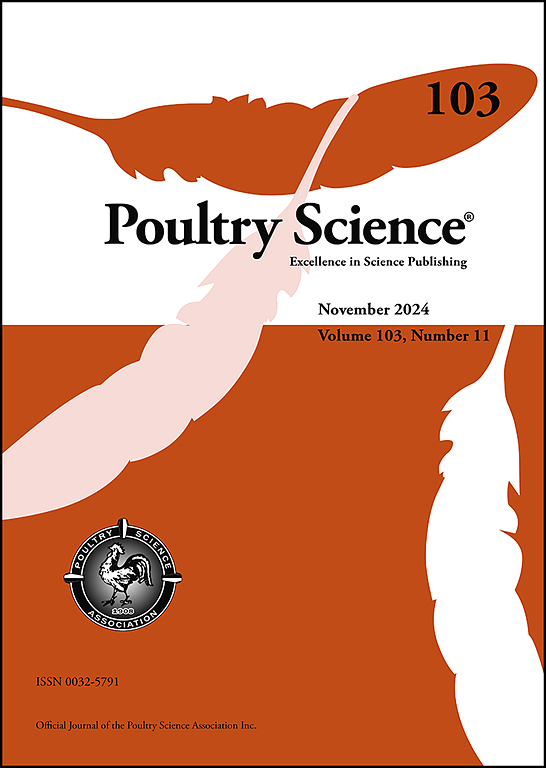一项初步研究表明,鸡将人类视为社会缓冲,可能会遵循人类给出的暗示
IF 3.8
1区 农林科学
Q1 AGRICULTURE, DAIRY & ANIMAL SCIENCE
引用次数: 0
摘要
在家养哺乳动物中广泛记录的对人类的积极看法,在家禽(如鸡)中的探索相对较少,现有的研究主要集中在减少恐惧上。这项研究评估了鸡是否积极地看待人类,考虑到互动类型和品种差异。两个品种(罗曼LSL经典,布朗经典)经历了13天的身体接触(PC),视觉接触(VC)或最少的人类接触(MC)。PC和VC: 1-2分钟/天)。研究人员通过三种行为测试来评估鸟类。在分离-团聚测试(第52-53天)中,受试者在野外环境中经历了两次3分钟的分离(实验者缺席)和团聚(实验者在场)。随后,实验者尝试了多达六次标准化的捕捉尝试来捕捉这些鸟(捕捉测试)。最后,局部增强测试(120-137天)评估了鸟类利用人类存在/手势定位食物的能力。在分离-团聚测试中,与独处相比,PC鸟在实验者在场时表现出更平静/积极的行为,如警惕性降低和觅食增加。相反,当实验者在场时,MC鸟表现出更少的平静行为和更大的退缩。与白色的鸟相比,棕色的鸟表现出更平静的行为,更少的运动,花更多的时间在实验者身边。捕获测试支持这些结果,PC和棕色鸟类更容易捕获。在局部增强测试中,两个PC个体和棕色PC组作为一个整体成功地使用人类给出的线索来定位食物奖励。这些结果表明,正如在其他物种中观察到的那样,鸡——尤其是那些有积极的人类经历的鸡——可以将人类与有益的结果联系起来。积极的互动也可能使鸡将人类视为社会缓冲器,也就是说,在具有挑战性的情况下,作为帮助减轻压力的因素。虽然是基础性的,但这项研究强调了品种敏感方法改善家禽福利的潜力,并开启了关于适应人类与动物相互作用以适应品种特异性特征的讨论。这些见解可以为提高福利的实践提供信息,并为农场管理提供实用工具,使动物和农民都受益。本文章由计算机程序翻译,如有差异,请以英文原文为准。
Chickens perceive humans as social buffers and may follow human-given cues: A pilot study
Positive perception of humans, extensively documented in domestic mammals, remains comparatively underexplored in domestic birds like chickens, with existing studies largely focusing on fear reduction. This research evaluated whether chickens perceive humans positively, accounting for interaction types and breed differences. Two breeds (Lohmann LSL Classic, Brown Classic) experienced physical contact (PC), visual-only contact (VC), or minimal human contact (MC) over 13 days (Days 35–51; PC and VC: 1–2 min/day). Birds were assessed using three behavioral tests. During the separation–reunion test (Days 52–53), individuals underwent two 3-min separations (experimenter absent) and reunions (experimenter present) in an open-field setting. Subsequently, the experimenter attempted up to six standardized capture attempts to catch the birds (the capture test). Lastly, the local enhancement test (Days 120–137) assessed birds' ability to use human presence/gestures to locate food. In the separation-reunion test, PC birds exhibited calmer/positive behaviors, such as reduced vigilance and increased foraging, in the presence of the experimenter compared to being alone. Conversely, MC birds displayed fewer calm behaviors and greater withdrawal when the experimenter was present. Brown birds showed more calm behaviors, reduced movement, and spent more time near the experimenter than white birds. The capture test supported these results, with PC and brown birds being easier to capture. In the local enhancement test, two PC individuals and the brown PC group as a whole successfully used human-given cues to locate food rewards. These results indicate that, as observed in other species, chickens—especially those with positive human experiences—can associate humans with rewarding outcomes. Positive interactions may also lead chickens to perceive humans as social buffers—that is, as factors that help mitigate stress in challenging situations. Although fundamental, this study highlights the potential of breed-sensitive approaches to improve poultry welfare and opens the discussion on adapting human–animal interactions to breed-specific characteristics. These insights can inform welfare-enhancing practices and provide practical tools for on-farm management that benefit both animals and farmers.
求助全文
通过发布文献求助,成功后即可免费获取论文全文。
去求助
来源期刊

Poultry Science
农林科学-奶制品与动物科学
CiteScore
7.60
自引率
15.90%
发文量
0
审稿时长
94 days
期刊介绍:
First self-published in 1921, Poultry Science is an internationally renowned monthly journal, known as the authoritative source for a broad range of poultry information and high-caliber research. The journal plays a pivotal role in the dissemination of preeminent poultry-related knowledge across all disciplines. As of January 2020, Poultry Science will become an Open Access journal with no subscription charges, meaning authors who publish here can make their research immediately, permanently, and freely accessible worldwide while retaining copyright to their work. Papers submitted for publication after October 1, 2019 will be published as Open Access papers.
An international journal, Poultry Science publishes original papers, research notes, symposium papers, and reviews of basic science as applied to poultry. This authoritative source of poultry information is consistently ranked by ISI Impact Factor as one of the top 10 agriculture, dairy and animal science journals to deliver high-caliber research. Currently it is the highest-ranked (by Impact Factor and Eigenfactor) journal dedicated to publishing poultry research. Subject areas include breeding, genetics, education, production, management, environment, health, behavior, welfare, immunology, molecular biology, metabolism, nutrition, physiology, reproduction, processing, and products.
 求助内容:
求助内容: 应助结果提醒方式:
应助结果提醒方式:


